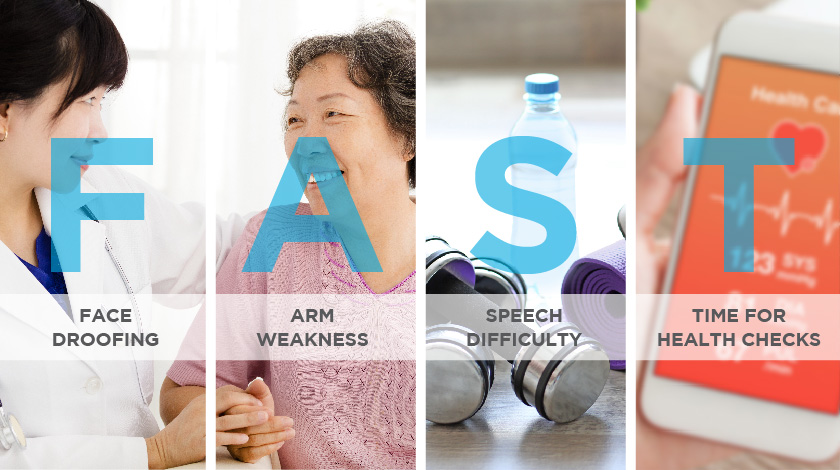Nearly three thousand people die of stroke each year in Hong Kong. That fatality rate may be falling fast thanks to advancements in early detection and treatment, but the incidence of stroke shows no sign of slowing down. A recent study by the Hong Kong Health and Health Services Research Fund predicts that the absolute number of patients suffering from stroke – or cerebrovascular disease - will continue to increase in the coming years, driven by an ageing population and various lifestyle factors.
Types of Stroke
Strokes can be classified into 2 main categories, ischemic strokes and hemorrhagic stroke, and there is about 80% of all strokes are ischemic in Hong Kong.
- Ischemic strokes:
They are caused by thrombosis and embolism due to blockage of an artery. Cerebral thrombosis Is caused by the blood clot forming in the brain's venous sinuses, while embolic stroke is caused by a clot that travels from the aorta to the cerebral vessel.
- Hemorrhagic strokes:
They are caused by bleeding, usually occurs when a blood vessel in the brain ruptures or leaks.
Stroke Warning Signs
In most cases, the symptoms of stroke include blurred vision, double vision, sudden blurry vision in one eye, and even sudden loss of vision. In addition, body parts such as the face, lips, tongue, hands and feet may also experience periodic paralysis, or loss of pain and temperature perception. To help laymen recognise early-onset symptoms of stroke and take speedy action, researchers have coined the handy acronym, F.A.S.T. These letters stand for:
- Face drooping (a lopsided smile being the primary example);
- Arm weakness (especially when confined to one arm);
- Speech difficulty (slurring speech and inability to convey simple information should set alarm bells ringing); and
- Time to call 999
By keeping a lookout for these symptoms in your friends, family and coworkers, you might just be able to save a life. And needless to say, if you notice any of these symptoms in your own body, it’s time to call an ambulance – fast.
Risk Factors for Stroke

A nutritious diet and regular exercise have been touted for decades as the twin pillars to a long, healthy life. Yet as the pressures of work and family take their toll, many working adults allow their discipline to fall by the wayside. Below are the risk factors for stroke.
- People who eat higher levels of red and processed meat increase their risk of stroke up to 15%.
- Those who are physically sedentary are almost 1.5 times more likely to suffer an ischaemic stroke.
- Age increases your chances for stroke
- Men at higher risk for stroke than women
- High in blood pressure, blood lipids or cholesterol
- Diabetic患者
- Overweight
- Suffer from heart disease or vascular diseases such as coronary heart disease and heart arrhythmia
- Suffering from congenital cerebrovascular disease
- Have a family history of stroke or heart disease
- Smoking
- Alcoholism
- Lack of exercise
If you want to minimise these risks, start by cutting back on your fat and salt intakes and get some light cardiovascular exercise at least twice a week. Even a quick 30 minute stroll after dinner can do wonders!
Ways to Prevent Stroke
Recently, strokes among young people are on the rise. If you want to reduce your stroke risk, you are advised to maintain healthy habits. As with heart and kidney disease, the risk of stroke can be effectively controlled by the following ways.
- Improve your eating habits to control blood pressure, blood sugar and cholesterol
- Have a physical exam at least every other year if you suffer from high blood pressure, high cholesterol, diabetes, or heart disease
- Quit smoking to reduce the risk of vessel blockage caused by increasing in the blood cholesterol
- Exercise regularly, 150 minutes a week of moderate-intensity activity is recommended
- Manage your weight
- Reduce stress by staying optimistic

Medical Screenings
The old saying that prevention is better than cure has never been more apt than when applied to this debilitating affliction – when Hong Kong’s 5-year stroke recurrence rate may be as high as 23.1%, why take chances?
There’s one risk factor for cerebrovascular disease that we can’t control, and that’s age. Stroke risk doubles every decade after age 55 (that figure may be even higher for men, who are more prone to stroke).
That’s why medical screenings are imperative for our elderly friends and relatives. Spotting related diseases like heart disease, liver cirrhosis and diabetes early, and seeking appropriate treatment, can help prevent a crippling stroke down the road. Of course, regular screenings may seem expensive. But good health is priceless, and it’s an essential investment if we are to ensure our loved ones’ golden years are truly golden.
The devastating effects of stroke range from paralysis to prolonged comas and, in many cases, death. Don’t let things get out of hand. By following the simple guide we’ve outlined here for prevention and early detection, we can repel the scourge of cerebrovascular disease, and make progress towards a stroke-free Hong Kong.
Sources:
- Stroke incidence and mortality trends in Hong Kong: implications for public health education efforts and health resource utilisation, by J Woo *, SC Ho, W Goggins, PH Chau, SV Lo. June 2014.
- The stroke epidemic, by PW Ng. April 2007.
- Non-Communicable Diseases Watch. Oct 2013.
- Use the letters in "F.A.S.T." to spot stroke signs and know when to call 9-1-1.
- Sex Differences in Stroke Epidemiology, by P Appelros. April 2009.
- 何謂中風及中風的種類
- 智友站- 中風 - 醫院管理局
- 中風- 中風成因、病徵、急救、治療、康復及預防方法全面看

